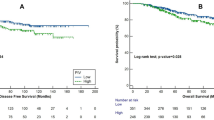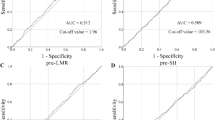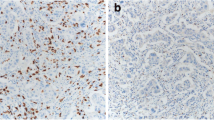Abstract
Background
Tumor-infiltrating lymphocytes (TILs) predict response to neoadjuvant chemotherapy (NAC) in triple-negative breast cancer (TNBC) patients. However, the TIL level can be determined at a few facilities. By contrast, neutrophil-to-lymphocyte ratio (NLR) and platelet-to-lymphocyte ratio (PLR) are easily and objectively determined from the results of full blood counts. We conducted a retrospective study to investigate whether TILs, NLR, and PLR predict NAC efficacy and whether NLR and PLR could be surrogate markers for TILs in TNBC.
Methods
Of the 266 patients diagnosed with TNBC between 2013 and 2019, 66 who underwent radical surgery after sequential administration of anthracycline and taxane as NAC were included in the study. TILs, NLR, and PLR were evaluated as predictors of pathologic complete response (pCR) using cutoff values determined from receiver operating characteristic curves.
Results
The cutoff values of TILs, NLR, and PLR were 20%, 2.6, and 180, respectively. High TIL level was associated with low NLR (P = 0.01) and low PLR (P = 0.01). High TIL level (odds ratio [OR] 4.28 [95% CI 1.40–13.1]; P = 0.01), low NLR (OR 5.51 [95% CI 1.60–18.9]; P = 0.01), and low PLR (OR 3.29 [95% CI 1.13–9.57]; P = 0.03) were associated with pCR. Low NLR predicted pCR independently (OR 6.59 [95% CI 1.45–30.0]; P = 0.01).
Conclusions
TILs, NLR, and PLR predicted NAC efficacy against TNBC. TIL level was associated with NLR and PLR. NLR was an independent predictive factor and may be a useful surrogate marker for TILs when predicting pCR.



Similar content being viewed by others
Data availability
Data available on request due to privacy/ethical restrictions.
Change history
15 October 2023
Supplementary figure was missing from this article and has now been uploaded.
References
den Brok WD, Speers CH, Gondara L, Baxter E, Tyldesley SK, Lohrisch CA. Survival with metastatic breast cancer based on initial presentation, de novo versus relapsed. Breast Cancer Res Treat. 2017;161(3):549–56. https://doi.org/10.1007/s10549-016-4080-9.
Cortazar P, Zhang L, Untch M, Mehta K, Costantino JP, Wolmark N, et al. Pathological complete response and long-term clinical benefit in breast cancer: the CTNeoBC pooled analysis. Lancet. 2014;384(9938):164–72. https://doi.org/10.1016/S0140-6736(13)62422-8.
Schmid P, Cortes J, Dent R, Pusztai L, McArthur H, Kümmel S, et al. KEYNOTE-522 Investigators. Event-free survival with pembrolizumab in early triple-negative breast cancer. N Engl J Med. 2022;386(6):556–67. https://doi.org/10.1056/NEJMoa2112651.
Alexandrov LB, Nik-Zainal S, Wedge DC, Aparicio SAJR, Behjati S, Biankin AV, et al. Signatures of mutational processes in human cancer. Nature. 2013;500(7463):415–21. https://doi.org/10.1038/nature12477.
Denkert C, von Minckwitz G, Darb-Esfahani S, Lederer B, Heppner BI, Weber KE, et al. Tumour-infiltrating lymphocytes and prognosis in different subtypes of breast cancer: a pooled analysis of 3771 patients treated with neoadjuvant therapy. Lancet Oncol. 2018;19(1):40–50. https://doi.org/10.1016/S1470-2045(17)30904-X.
O’Loughlin M, Andreu X, Bianchi S, Chemielik E, Cordoba A, Cserni G, et al. Reproducibility and predictive value of scoring stromal tumour infiltrating lymphocytes in triple-negative breast cancer: a multi-institutional study. Breast Cancer Res Treat. 2018;171(1):1–9. https://doi.org/10.1007/s10549-018-4825-8.
Ethier JL, Desautels D, Templeton A, Shah PS, Amir E. Prognostic role of neutrophil-to-lymphocyte ratio in breast cancer: a systematic review and meta-analysis. Breast Cancer Res. 2017;19(1):2. https://doi.org/10.1186/s13058-016-0794-1.
Miyagawa Y, Araki K, Bun A, Ozawa H, Fujimoto Y, Higuchi T, et al. Significant association between low baseline neutrophil-to-lymphocyte ratio and improved progression-free survival of patients with locally advanced or metastatic breast cancer treated with eribulin but not with nab-paclitaxel. Clin Breast Cancer. 2018;18(5):400–9. https://doi.org/10.1016/j.clbc.2018.03.002.
Pang J, Zhou H, Dong X, Wang S, Xiao Z. Relationship between the neutrophil to lymphocyte ratio, stromal tumor-infiltrating lymphocytes, and the prognosis and response to neoadjuvant chemotherapy in triple-negative breast cancer. Clin Breast Cancer. 2021;21(6):e681–7. https://doi.org/10.1016/j.clbc.2021.04.004.
Chae S, Kang KM, Kim HJ, Kang E, Park SY, Kim JH, et al. Neutrophil–lymphocyte ratio predicts response to chemotherapy in triple-negative breast cancer. Curr Oncol. 2018;25(2):e113–9. https://doi.org/10.3747/co.25.3888.
Asano Y, Kashiwagi S, Onoda N, Noda S, Kawajiri H, Takashima T, et al. Predictive value of neutrophil/lymphocyte ratio for efficacy of preoperative chemotherapy in triple-negative breast cancer. Ann Surg Oncol. 2016;23(4):1104–10. https://doi.org/10.1245/s10434-015-4934-0.
Wu Q, Ma G, Deng Y, Luo W, Zhao Y, Li W, et al. Prognostic value of Ki-67 in patients with resected triple-negative breast cancer: a meta-analysis. Front Oncol. 2019;9:1068. https://doi.org/10.3389/fonc.2019.01068.
Salgado R, Denkert C, Demaria S, Sirtaine N, Klauschen F, Pruneri G, et al. International TILs Working Group 2014 The evaluation of tumor-infiltrating lymphocytes (TILs) in breast cancer: recommendations by an International TILs Working Group 2014. Ann Oncol. 2015;26(2):259–71. https://doi.org/10.1093/annonc/mdu450.
Kobayashi K, Horii R, Ito Y, Miyagi Y, Ohno S, Iwase T, et al. Prognostic significance of histological therapeutic effect in preoperative chemotherapy for breast cancer. Pathol Int. 2016;66(1):8–14. https://doi.org/10.1111/pin.12365.
Mukai H, Arihiro K, Shimizu C, Masuda N, Miyagi Y, Yamaguchi T, et al. Stratifying the outcome after neoadjuvant treatment using pathological response classification by the Japanese Breast Cancer Society. Breast Cancer. 2016;23(1):73–7. https://doi.org/10.1007/s12282-015-0640-9.
Petekkaya I, Unlu O, Roach EC, Gecmez G, Okoh AK, Babacan T, et al. Prognostic role of inflammatory biomarkers in metastatic breast cancer. J BUON. 2017;22(3):614–22.
Gao G, Wang Z, Qu X, Zhang Z. Prognostic value of tumor-infiltrating lymphocytes in patients with triple-negative breast cancer: a systematic review and meta-analysis. BMC Cancer. 2020;20(1):179. https://doi.org/10.1186/s12885-020-6668-z.
Lusho S, Durando X, Mouret-Reynier MA, Kossai M, Lacrampe N, Molnar I, et al. Platelet-to-lymphocyte ratio is associated with favorable response to neoadjuvant chemotherapy in triple negative breast cancer: a study on 120 patients. Front Oncol. 2021;11:678315. https://doi.org/10.3389/fonc.2021.678315.
Dieci MV, Criscitiello C, Goubar A, Viale G, Conte P, Guarneri V, et al. Prognostic value of tumor-infiltrating lymphocytes on residual disease after primary chemotherapy for triple-negative breast cancer: a retrospective multicenter study. Ann Oncol. 2014;25(3):611–8. https://doi.org/10.1093/annonc/mdt556.
Galvez M, Castaneda CA, Sanchez J, Castillo M, Rebaza LP, Calderon G, et al. Clinicopathological predictors of long-term benefit in breast cancer treated with neoadjuvant chemotherapy. World J Clin Oncol. 2018;9(2):33–41. https://doi.org/10.5306/wjco.v9.i2.33.
Hida AI, Sagara Y, Yotsumoto D, Kanemitsu S, Kawano J, Baba S, et al. Prognostic and predictive impacts of tumor-infiltrating lymphocytes differ between triple-negative and HER2-positive breast cancers treated with standard systemic therapies. Breast Cancer Res Treat. 2016;158(1):1–9. https://doi.org/10.1007/s10549-016-3848-2.
von Minckwitz G, Schneeweiss A, Loibl S, Salat C, Denkert C, Rezai M, et al. Neoadjuvant carboplatin in patients with triple-negative and HER2-positive early breast cancer (GeparSixto; GBG 66): a randomised phase 2 trial. Lancet Oncol. 2014;15(7):747–56. https://doi.org/10.1016/S1470-2045(14)70160-3.
Russo L, Maltese A, Betancourt L, Romero G, Cialoni D, De la Fuente L, et al. Locally advanced breast cancer: tumor-infiltrating lymphocytes as a predictive factor of response to neoadjuvant chemotherapy. Eur J Surg Oncol. 2019;45(6):963–8. https://doi.org/10.1016/j.ejso.2019.01.222.
Mori H, Kubo M, Yamaguchi R, Nishimura R, Osako T, Arima N, et al. The combination of PD-L1 expression and decreased tumor-infiltrating lymphocytes is associated with a poor prognosis in triple-negative breast cancer. Oncotarget. 2017;8(9):15584–92. https://doi.org/10.18632/oncotarget.14698.
Park HS, Heo I, Kim JY, Kim S, Nam S, Park S, et al. No effect of tumor-infiltrating lymphocytes (TILs) on prognosis in patients with early triple-negative breast cancer: validation of recommendations by the International TILs Working Group 2014. J Surg Oncol. 2016;114(1):17–21. https://doi.org/10.1002/jso.24275.
Ruan M, Tian T, Rao J, Xu X, Yu B, Yang W, et al. Predictive value of tumor-infiltrating lymphocytes to pathological complete response in neoadjuvant treated triple-negative breast cancers. Diagn Pathol. 2018;13(1):66. https://doi.org/10.1186/s13000-018-0743-7.
Asano Y, Kashiwagi S, Onoda N, Noda S, Kawajiri H, Takashima T, et al. Platelet–lymphocyte ratio as a useful predictor of the therapeutic effect of neoadjuvant chemotherapy in breast cancer. PLoS ONE. 2016;11(7):e0153459. https://doi.org/10.1371/journal.pone.0153459.
Onagi H, Horimoto Y, Sakaguchi A, Ikarashi D, Yanagisawa N, Nakayama T, et al. High platelet-to-lymphocyte ratios in triple-negative breast cancer associates with immunosuppressive status of TILs. Breast Cancer Res. 2022;24(1):67. https://doi.org/10.1186/s13058-022-01563-7.
van der Hage JA, van de Velde CJ, Julien JP, Tubiana-Hulin M, Vandervelden C, Duchateau L. Preoperative chemotherapy in primary operable breast cancer: results from the European Organization for Research and Treatment of Cancer trial 10902. J Clin Oncol. 2001;19(22):4224–37. https://doi.org/10.1200/JCO.2001.19.22.4224.
Matlung HL, Babes L, Zhao XW, van Houdt M, Treffers LW, van Rees DJ, et al. Neutrophils kill antibody-opsonized cancer cells by trogoptosis. Cell Rep. 2018;23(13):3946-59.e6. https://doi.org/10.1016/j.celrep.2018.05.082.
Hubert P, Heitzmann A, Viel S, Nicolas A, Sastre-Garau X, Oppezzo P, et al. Antibody-dependent cell cytotoxicity synapses form in mice during tumor-specific antibody immunotherapy. Cancer Res. 2011;71(15):5134–43. https://doi.org/10.1158/0008-5472.CAN-10-4222.
Coussens LM, Werb Z. Inflammation and cancer. Nature. 2002;420(6917):860–7. https://doi.org/10.1038/nature01322.
Condeelis J, Pollard JW. Macrophages: obligate partners for tumor cell migration, invasion, and metastasis. Cell. 2006;124(2):263–6. https://doi.org/10.1016/j.cell.2006.01.007.
Xiong S, Dong L, Cheng L. Neutrophils in cancer carcinogenesis and metastasis. J Hematol Oncol. 2021;14(1):173. https://doi.org/10.1186/s13045-021-01187-y.
Funding
No specific funding was disclosed.
Author information
Authors and Affiliations
Contributions
HK: conceptualization, data curation, formal analysis, investigation, methodology, visualization, and writing––original draft preparation. NK: editing, visualization, resources, and writing––review and editing. AS: resources. AT: resources. HK: resources. SN: resources. YO: resources. YS: resources. JO: resources. NW: resources. SM: resources. MN: resources. FF: resources. KH: methodology and resources. YT: resources. TN: project administration, resources, visualization, and writing––review and editing. All authors critically reviewed and approved the final manuscript.
Corresponding author
Ethics declarations
Conflict of interest
Takahiro Nakayama received honoraria (lecture fees) unrelated to this work from Eli Lilly, Pfizer, Daiichi Sankyo, Eisai, AstraZeneca, Chugai Pharmaceutical, Sandoz, Novartis, and MSD. The other authors declare no conflict of interest.
Additional information
Publisher's Note
Springer Nature remains neutral with regard to jurisdictional claims in published maps and institutional affiliations.
Supplementary Information
Below is the link to the electronic supplementary material.
About this article
Cite this article
Kusama, H., Kittaka, N., Soma, A. et al. Predictive factors for response to neoadjuvant chemotherapy: inflammatory and immune markers in triple-negative breast cancer. Breast Cancer 30, 1085–1093 (2023). https://doi.org/10.1007/s12282-023-01504-y
Received:
Accepted:
Published:
Issue Date:
DOI: https://doi.org/10.1007/s12282-023-01504-y




